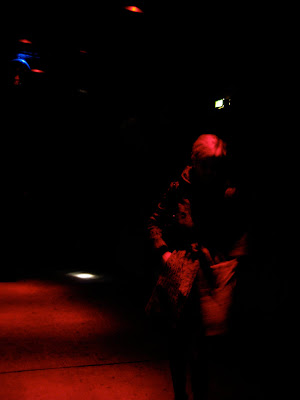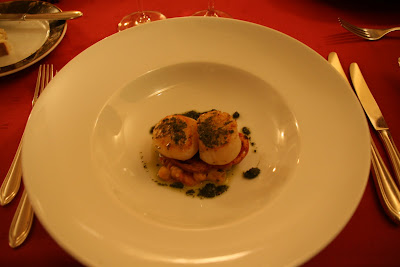
Berlin, Germany
So by now you may have heard of the secret restaurant trend in Europe – Berlin, London (watch this space for what may become one in Hamburg). This article in the NYT documents the author’s experience in a few of the better-known secrets (as someone put it, "how 'secret' can they be if they are in the New York Times?’ Point well taken.). With only 36 hours on a quick trip to Berlin at the end of October, I decided that this was the place to start.
I had first heard about Cookies Cream from my friend Eva who was invited to a dinner there for the premier of Tilda Swinton’s film, Julia, at the 2007 Berlinale film festival. She raved about the amazing vegetarian food served in this strange back-alley hidden restaurant, and about Tilda’s hot young lover. Anyway, I was intrigued – was it something that was set up especially for the evening, a one-time deal catered by the Westin Grand, the hotel whose dumpsters you have to walk past to get up the back staircase? Turns out, no. In fact, when I spoke to my neighbors, Berlin transplants in Hamburg, about my „secret“ dinners, they were rather unimpressed that Cookies Cream was considered a secret.
We had an 8 o’clock reservation. Everything about the place said clandestine, from the obscure entrance, to the very unfinished look of the bathroom, to the open kitchen.

Walk past the Westin Grand main entrance and take a right into the first alleyway.

Presumably the Westin Grand's garbage. You are in the right place. Keep going.

Ah, chandelier-lit dumpsters. So romantic. Pass underneath the chandelier and up the stairs to the right. The Cookies Cream placard is there on the wall. Ring the bell, someone will buzz you in.

Up the backstairs to the dining room...and you enter into a large divide space. The open kitchen is to the left and the dining area is to the right. White brick walls, white tablecloths, a large painting of square pastels with the word "fick" (f*ck) printed square in the center. The ceilings were high and lofty, the place was unfinished and polished at the same time. The details were purposefully makeshift - the sink in the bathroom designed to give the impression that the water would spill onto the floor, the seemingly random hole in the countertop were printed receipts sprouted. Somewhat contrived, but went with the theme.
 The menu was vegetarian, not vegan, and looked ambitious. We opted for the 3-gang / three course and the "house" drink, a rubarb vodka cocktail. Again, dining companions are for sharing and so my fellow diner Lowri and I passed the plates between us.
The menu was vegetarian, not vegan, and looked ambitious. We opted for the 3-gang / three course and the "house" drink, a rubarb vodka cocktail. Again, dining companions are for sharing and so my fellow diner Lowri and I passed the plates between us.Above, the Tete de Moine on a spinach tartlet, smoked topinambursalad with black nuts, sauce cumberland.
The Tete de Moine is a velvety swath of cheese swiveled off a large round mold. It sat atop a palak-like creamy spinach on what I can only describe as a cracker and next to a smoky sauerkraut (the topinambursalad – I am still not sure what this is). The black nut shaving was very earthy, like a ground nut but not as bitter, and the cumberland sauce was a sweet preserve. All together complementary, the smoothness and sharpenss of the cheese, creamy spinach and rough and smoky kraut worked well together.
But we really liked the stuffed brioche.

Presenting the stuffed brioche with quail egg, truffled foam of potatoes, red wine shallot.
The egg was silky and the potato foam hinted at celery, very faintly. The carmelized shallots were rich and sweet and tangy and the brioche wore them well.
 The tomato tandoori risotto defined fusion. You expected something a little more... Italian. But the spices were Indian, tumeric, cardamom, and the heat of the chillies. The goat cheese praline was an unexpected twist and lent the missing creaminess to the rice. A winner.
The tomato tandoori risotto defined fusion. You expected something a little more... Italian. But the spices were Indian, tumeric, cardamom, and the heat of the chillies. The goat cheese praline was an unexpected twist and lent the missing creaminess to the rice. A winner. The parmesan dumpling with cilantro carrots and Amalifi lemon sauce. Dumplings in my book are the ultimate comfort food. What could be better and more threatening to south beachers than a big ball of warm dough. Mmmmmmmmmmmmmmmm. The parmesan made it salty, savory, and the rest of it did't make that much of an impression because I was so overfocused on the dumpling itself, with a nutty pesto like mixture on top. It was perfect.
The parmesan dumpling with cilantro carrots and Amalifi lemon sauce. Dumplings in my book are the ultimate comfort food. What could be better and more threatening to south beachers than a big ball of warm dough. Mmmmmmmmmmmmmmmm. The parmesan made it salty, savory, and the rest of it did't make that much of an impression because I was so overfocused on the dumpling itself, with a nutty pesto like mixture on top. It was perfect.
Dessert, parfait of haselnuts, fruit salad. The salad was light, cleansing and the parfait surprisingly was too, even though it was richer. An appropriate ending to a meal whose main course was cheesy dough balls.
Overall a lovely evening, an inspired meat-free menu and intrigue.

Next stop: Tausend's backroom Cantina... I am still dreaming about it. O. Ma. Gah.

































